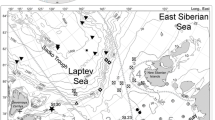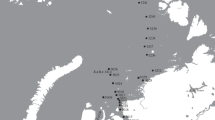Abstract
Qualitative samples were taken at 26 stations on the Great Meteor Seamount and in the surrounding deep sea in order to record the meiofauna and to allow first qualitative faunistic investigations. Among the 26 taxa of meiofauna found, nematodes and copepods were the most abundant. Study of the Copepoda Harpacticoida yielded 28 supraspecific taxa, of which 11 have been selected for further investigation at the species level. Of the 56 species determined, 54 are new to science. Two separate faunas can be distinguished: one on the plateau (29 species) and one in the surrounding deep sea (23 species). The number of overlapping species (i.e. recorded in both areas) is rather low (four species). The high number of new species can be taken as a sign of pronounced endemism.
Similar content being viewed by others
References
Andres GH (1977) Gammaridea (Crustacea, Amphipoda) aus dem Iberischen Tiefseebecken. Auswertung des Materials der Fahrten 3 und 15 von F.S. “Meteor”. Meteor Forsch-Ergebn D 25:54–67
Barnett PRO, Watson J, Connelly D (1984), A multiple corer for taking virtually undisturbed samples from shelf. bathyal and abyssal sediments. Oceanologica Acta 7:399–408
Bartsch I (1973a) Halacaridae (Acari) von der Josephinebank und der Großen Meteorbank aus dem östlichen Nordatlantik. I. Die Halacaridae aus den Schleppnetzproben. Meteor Forsch-Ergebn D 13:51–78
Bartsch I (1973b) Halacaridae (Acari) von der Josephinebank und der Großen Meteorbank aus dem östlichen Nordatiantik. II. Die Halacaridae aus den Bodengreiferproben. Meteor Forsch-Ergebn D 15:13–20
Bartsch I (1983) Ophiuroidea (Echinodermata) from the northeastern Atlantic deep sea. Meteor Forsch-Ergebn D 36:37–46
Brandt A, Barthelt D (1995) An improved supra- and epibenthic sledge for catching Peracarida (Crustacea, Malacostraca). Ophelia 43:15–23
Chislenko LL (1967) Copepoda Harpacticoida of the Karelian coast of the White Sea. Proc White Sea Biol Stat Zool Inst 7:48–196
Dietrich G, Kalle K, Kraus W, Siedler G (1994) Allgemeine Meereskunde. Gebr Bornträger Verlag, Berlin
Ehrich S (1977) Die Fischfauna der Großen Meteorbank. Meteor Forsch-Ergebn D 25:1–23
Ehrich S, John HC (1973) Zur Biologie und Ökologie der Schnepfenfische (Gattung Macrorhamphosus) vor Nordwestafrika und Überlegungen zum Altersaufbau der adulten Bestände der Großen Meteorbank. Meteor Forsch-Ergebn D 14:87–98
Emschermann P (1971) Loxomespilon perezi-ein Entoproctenfund im Mittelatiantik. Überlegungen zur Benthosbesiedlung der Großen Meteorbank. Mar Biol 9:51–62
Geddes DC (1981) Marine biological investigations in the Bahamas. 21. A new species of Cletopsyllus (Copepoda, Harpacticoida). Sarsia 66:287–291
George KH (1999) Gemeinschaftsanalytische Untersuchungen der Harpacticoidenfauna der Magellanregion, sowie erste similaritätsanalytische Vergleiche mit Assoziationen aus der Antarktis. Ber Polarforsch 327:1–187
Grasshoff M (1972) Die Gorgonarien des östlichen Nordatlantik und des Mittelmeeres. I. Die Familie Ellisellidae (Cnidaria, Anthozoa). Meteor Forsch-Ergebn D 10:73–87
Grasshoff M (1973) Die Gorgonarien des östlichen Nordatlantik und des Mittelmeeres. II. Die Gattung Acanthogorgia (Cnidaria: Anthozoa). Auswertung der “Atlantischen Kuppenfahrten 1967” von F.S. “Meteor”. Meteor Forsch-Ergebn D 13:1–10
Grasshoff M (1977) Die Gorgonarien des östlichen Nordatiantik und des Mittelmeeres. III. Die Familie Paramuriceidae (Cnidaria: Anthozoa). Meteor Forsch-Ergebn D 27:5–76
Grevemeyer I (1994) Der Atlantis-Meteor-Seamount Komplex. Berichte aus dem Zentrum für Meeres- und Klimaforschung C 5:1–126
Hartmann-Schröder G (1979) Die Polychaeten der “Atlantischen Kuppenfahrt” von F.S. “Meteor” (Fahrt 9 c. 1967). I. Proben aus Schieppgeräten. Meteor Forsch-Ergebn D 31:63–90
Hartmann-Schröder G (1981) Die Polychaeten der Fahrten 11, 19, 21, und 26 (1967–1972) von F.S. “Meteor” in das Gebiet zwischen dem Golf von Biscaya und dem Auftriebsgebiet vor Westafrika. Meteor Forsch-Ergebn D 33:23–36
Hempel G (1968) Biologische Arbeiten auf den Atlantischen Kuppenfahrten von FS “Meteor”. Naturwiss Rundschau 21/3:108–113
Hempel G (1970) Roßbreiten-Expedition des Forschungsschiffs Meteor. Naturwiss Rundschau 23/9:370–371
Hempel G, Nellen W (1972) Bericht über den Veriauf der Roßbreiten-Expedition 1970. Meteor Forsch-Ergebn A 10:51–78
Hessler RR, Jamars PA (1974) Abyssal community analysis from replicate box corers in the central North Pacific. Deep-Sea Res 21:185–209
Hinz K (1969) The Great Meteor Seamount. Results of seismic reflection measurements with a pneumatic sound source, and their geological interpretation. Meteor Forsch-Ergebn C 2:63–77
Horn W, Hussels W, Meincke J (1971) Schichtungs- und Strömungsmessungen im Bereich der Großen Meteorbank. Meteor Forsch-Ergebn A 9:31–46
Hubbs CL (1959) Initial discoveries of fish faunas on seamounts and offshore banks in the eastern Pacific. Pac Sci 13:311–316
Klie W (1950) Harpacticcida (Cop.) aus dem Bereich von Helgoland und der Kieler Buch II. Kieler Meeresforsch 7:76–128
Lang K (1948) Monographie der Harpacticiden. Hakan Ohlssons Boktryckeri, Lund
McIntyre AD, Warwick RM (1984) Meiofauna techniques. In: Holme NA, McIntyre AD (eds) Methods for the study of marine benthos. Blackwell Scientific Publications, Oxford, pp 217–244
Nellen W (1973) Untersuchungen zur Verteilung von Fischlarven und Plankton im Gebiet der Großen Meteorbank. Meteor Forsch-Ergebn D 13:47–69
Pfannkuche O, Thiel H (1988) in: Higgins RP, Thiel H (eds) Introduction to the study of meiofaura. Smithsonian Institution Press, Washington D.C., pp 134–145
Pfannkuche O, Müller TJ, Nellen W, Wefer, G (eds) (2000) Meteorberichte 00–1 Ostatlantik 1998. Cruise No. 42, 16 June-26 October 1998. Leitstelle METEOR. Institut für Meereskunde der Universität Hamburg, Hamburg
Richer de Forges B, Koslow JA, Poore CGB (2000) Diversity and endemism of the benthic seamount fauna in the southwest Pacific. Nature 405:944–947
Rogers AD (1994) The biology of seamounts. Adv Mar Biol 30:305–350
Thiel H (1970) Bericht über die Benthosuntersuchungen während der “Atlantischen Kuppenfahrten 1967” von F.S. “Meteor”. Meteor Forsch-Ergebn D 7:23–42
Ulrich J (1971) Zur Topographie und Morphologie der Großen Meteorbank. Meteor Forsch-Ergebn C 6:48–68
Author information
Authors and Affiliations
Corresponding author
Additional information
Communicated by O. Kinne, Oldendorf/Luhe
Published online: 14 August 2002
An erratum to this article is available at http://dx.doi.org/10.1007/s00227-005-1559-z.
Rights and permissions
About this article
Cite this article
George, K.H., Schminke, H.K. Harpacticoida (crustacea, copepoda) of the great meteor seamount, with first conclusions as to the origin of the plateau fauna. Marine Biology 141, 887–895 (2002). https://doi.org/10.1007/s00227-002-0878-6
Received:
Accepted:
Issue Date:
DOI: https://doi.org/10.1007/s00227-002-0878-6




